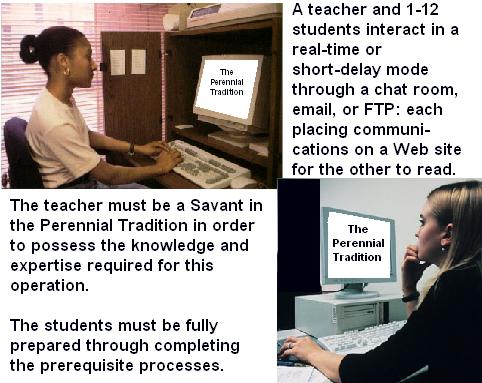Part of the difficulty with written expressions of dialectic, during Plato's time, was that they could "neither speak for themselves nor teach the truth adequately to others." Written expositions couldn't interact with the reader.  During Plato's era, it was correct to say (as he does in Phaedrus):
During Plato's era, it was correct to say (as he does in Phaedrus):
"Only in principles of justice and goodness and nobility taught and communicated orally for the sake of instruction and graven in the soul, which is the true way of writing, is there clearness and perfection and seriousness."
However, Plato was aware that even in his day writing possessed the revelatory function of bringing essential concepts to mind for those who were already prepared and possessed basic knowledge. It was for this reason that Plato wrote in the dialogical mode: to introduce readers to dialectic, allowing them to engage in this mystical experience through their virtual participation with Socrates and the other participants.
 With the introduction of the Internet, the nature of written expression of ideas has undergone a revolutionary transformation. The Perennialist Teacher and the seeker can interact in a real-time environment, exchanging ideas and investigating issues in synchronous or asynchronous mode.
With the introduction of the Internet, the nature of written expression of ideas has undergone a revolutionary transformation. The Perennialist Teacher and the seeker can interact in a real-time environment, exchanging ideas and investigating issues in synchronous or asynchronous mode.
As is the case in all genuine learning environments, only those students who have the necessary moral and intellectual capabilities are able to pursue the path of knowledge in all its manifestations and achieve understanding of higher consciousness. Of equal importance, only an adept in the Perennial Tradition can initiate a genuine dialectical interchange, since only she possesses the requisite capabilities to make it operative in its higher mode. In the last stage, the Teacher and the seeker must come into physical contact to complete the process.
The New Dialectic is focused interchange,
 engaged in intentionally with the goal of increasing understanding, exploring issues, and evaluating thoughts or actions. It engages the heart as well as the mind. It is different from ordinary, everyday conversation, in that dialectic has a focus and a purpose, and is part of a comprehensive system of transformation. Dialectic does not involve debate, which presents two points of view with the goal of proving the supremacy or correctness of one of the viewpoints over the other. The New Dialectic, unlike debate or even discussion, is as interested in the relationship between the participants as it is in the theme being explored. Ultimately, New Dialectic presupposes an openness to modify deeply held convictions.
engaged in intentionally with the goal of increasing understanding, exploring issues, and evaluating thoughts or actions. It engages the heart as well as the mind. It is different from ordinary, everyday conversation, in that dialectic has a focus and a purpose, and is part of a comprehensive system of transformation. Dialectic does not involve debate, which presents two points of view with the goal of proving the supremacy or correctness of one of the viewpoints over the other. The New Dialectic, unlike debate or even discussion, is as interested in the relationship between the participants as it is in the theme being explored. Ultimately, New Dialectic presupposes an openness to modify deeply held convictions.
